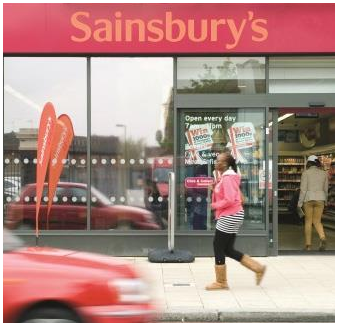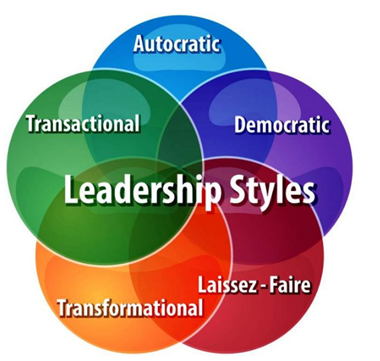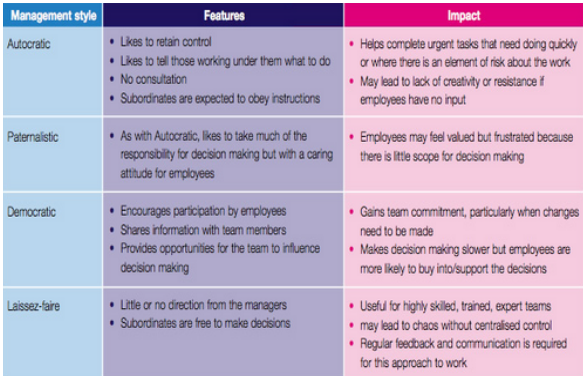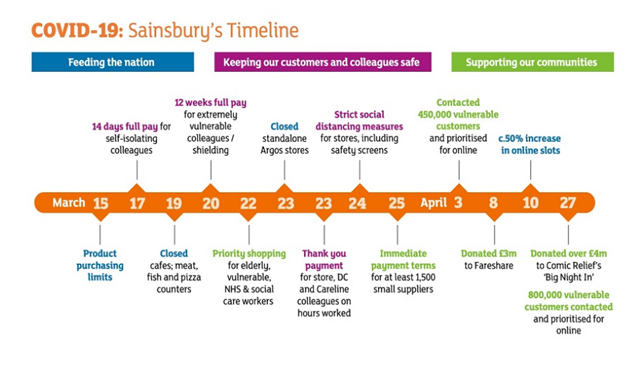Leadership Assignment: Transformational Management at Sainsbury Post-Pandemic
Question
Task:
Write a report on leadership assignment on the impact of the current post-pandemic situation on Management and Leadership in a specific organization.
o Choose a company or organization and investigate how their Management and Leadership styles have changed over the course of the pandemic, and what new skills Managers and Leaders need to be successful in the post pandemic world.
§ First select an organization and describe it, including business name, sector, and company size as a minimum and justify your selection
§ Analyze the leadership styles that were prevalent in the organization prior to the pandemic, and identify any changes that occurred over the last 18 months, taking into consideration process and people management aspects (you may make assumptions, providing theoretically sound rationale)
§ Advise which personal decision style is recommendable in the current situation. Make a suggestion based on your views and provide theoretically sound rationale for your decision
§ Reflect on the impact of the digital age on required management skills
Answer
Background of leadership assignment
Leadership is an act of persuading people towards a common objective. It plays a major role in the efficient utilisation of resources and achievement of objectives. It is important for the organisation as it contributes to the rapid growth of the organisation. The main focus of leadership is to maintain a cordial and healthy working environment leading to improved efficiency of employees. Leadership aims at bringing the organisation together towards the achievement of the goal. During the pandemic, period leadership has played a salient role in the smooth running of the business. Due to the pandemic, the organisation had to suffer a loss due to inefficiency of employees, lack of resources, shortage of finance. It is because of effective leadership and management skills that organisations could compensate for the impact of pandemics. The scope of the essay discusses the importance of leadership during the pandemic and the change in the organisation's leadership style due to pandemics. These are discussed in context to Sainsbury. It is a multinational retail industry based in the United Kingdom. This essay discusses the brief of the Sainsbury organisation, the leadership style adopted by the organisation in the post-pandemic period, and the change in leadership style due to pandemics. Further, the recommendations are provided regarding the leadership style suited to the pandemic situation and the digital age's impact on management.
Sainsbury brief
Sainsbury is a multinational retail industry formed and based in the United Kingdom. The products of Sainsbury include a supermarket, hypermarket, convenience shop and forecourt shops. The company success lies in its management skills and marketing ideas. It attracts and retains its customer by offering varieties at low prices. It is the second-largest retail sector in the United Kingdom. Sainsbury provides varieties of products to its customers at one shop leading to the comfort and attractiveness of the customers. The strength of the company lies in its diversified quality product offering at a low price (sainsburys.co.uk, 2020). Sainsbury weakness lies in its low margins, growing costs and limited success. The company needs to strengthen its weakness to neutralize the threat of competitors, pandemics, digitisation and grab the opportunity of online services, new trends and innovative technology. The leadership and management of Sainsbury should focus on neutralising threats and grabbing the opportunity. The political, legal, social, economic, and environmental factors guide the management to take necessary actions to effectively and efficiently utilise objectives. The competitive advantage of Sainsbury leading to the success of the business is its strategy to develop its products according to the needs of customers, and healthy quality food at a reasonable price attracts the customer. Its strategy to focus on customer health and provide varieties of products to all its target market belonging to different age groups at the convenience of the customers leads to the rapid growth of the industry in the pandemic period (Fiazet al., 2017). Sainsbury is successful in fulfilling its social responsibility towards the environment leading to an improved reputation of the business. Leadership and management play a significant role in analysingcustomer’s needs and therefore forms the strategies to satisfy all wants of customers. The management motivates the employees to work for the best interest of the customers leading to the success of the business.

Figure 1: Sainsbury’s Store
(Source: retail-week.com, 2021)
Leadership style before the pandemic
Sainsbury's main success lies in its effective leadership strategy. The leaders of Sainsbury ensure a cordial and friendly working environment to motivate the employees. The main focus of Sainsbury leaders is to ensure facilities and high-level motivation to the employees.
There are three different types of leadership styles: transactional, transformational and laissez-faire.
Transactional: It refers to the leadership style that sets the goals and objectives of the organisation and conveys the same to the employees. This gives a clear understanding to the employees about the work expected from them (Saeed and Mughal, 2019). It helps the employees to improve efficiency as employees are aware of the task and goals of the organisation. Transactional leadership ensures smooth business functioning and increases productivity. The leadership style is successful in improving employees’ information through reward and punishment strategy (Al Khajeh, 2018). Therefore by appreciating the best performers and punishing the underperformers, this style improves efficiency, thereby increasing productivity.
Transformational: This leadership style forms long term objectives for the organisation. These objectives are communicated to all the organisation's employees to give the employees a clear understanding of the company's vision and mission (Andrianiet al., 2018). The leaders of Sainsbury guide ways to the employees to successfully achieve the organisation goals. This helps the employees to be dedicated and motivated towards the work. Thereby, it increasesemployee’s productivity (Al-Daibat, 2017). The transformational leadership style is effective to initiate impactful changes in the organisation.

Figure 2: Leadership Styles
(Source: boostyourleadershipskills.com, 2020)
Laissez-faire: This leadership style focuses on empowering the employees. The tasks of the organisation are in the authority of the employees. This is done to make the employees feel worthy. It helps the employees to be motivated, thereby increasing their productivity. Laissez-faire leadership style can be adopted by the organisation only if the employees are highly qualified, efficient and experienced. Sainsbury uses a transformational leadership approach. The organisation's goals are set, and these are communicated to employees to give the employees a clear understanding of the work (Builet al., 2019). The leaders of Sainsbury guide the employees to achieve its objectives effectively. Sainsbury leaders ensure a motivated and friendly working environment to improve employee’s efficiency, thereby increasing productivity. It ensures impactful changes at Sainsbury (Topet al., 2020).
Management style at Sainsbury
There are different types of management styles. The organisation adopts these management styles based on its objectives.
Different management styles are Autocratic and Democratic management style.
Autocratic management styles: An Autocratic management style is a traditional approach towards leadership. In this style, the leaders do not convey their important decision and operational performance to employees. The leaders consider themselves as superior and so do not consult the employees in important decisions. This, in turn, reduces employees' motivation, thereby leading to reduced productivity.
Democratic leadership style: Democratic leadership is a modern approach to leadership. This leadership style values the employees of the organisation. In this style, the top management discusses important decisions with the organisation's employees to make the employees feel motivated. The increased motivation helps the employees increase their productivity, thereby leading to the organisation's achievement (circlebizz.com, 2020).
Sainsbury uses the Democratic style of leadership as Sainsbury leaders believe in ensuring a cordial and friendly working environment for employees. The leaders focus on ensuring high motivation and productivity of employees. Leaders at Sainsbury discuss salient decisions with employees. All the activities of the organisation involve employees, thereby leading to high motivation and productivity. Sainsbury's success lies in its effective management style.

Figure 3: Management styles
(Source: msrblog.com, 2021)
Change in Leadership and management style due to pandemic
Leadership and management play an important role in compensating for the losses of the pandemic. The employees suffered financial and emotional losses leading to decreased motivation and productivity of the employees. Due to lockdown, the organisation had to suffer a shortage of labour and finance (Ciulla, 2020). Due to the pandemic, the organisation had to undergo several changes to increase its efficiency and productivity. It was because of the leaders that the organisation and the employees could positively adapt to the changes.
The changes in Sainsbury leadership strategies in response to the pandemic are:
Due to the pandemic, the health of employees deteriorated, many employees were emotionally disturbed as they had lost their families due to the pandemic.
1. 1 Sainsbury leaders worked to motivate the employees. The leaders took decisions in consultation with experienced employees to make the employees feel worthy and important. To motivate the employee's leaders focused on initiating ways to improve employee’s health by free testing, sanitisation, vaccination. This made the employees feel protective and thereby motivated the employees leading to improved productivity.
2. Sainsbury leaders adapted to the changes positively. Due to the pandemic, there have been several innovative technological changes. Sainsbury shifted to online business to attract a large number of people. Leaders at Sainsbury focused on providing quality services, quality food, and timely delivery to customers at the convenience of the customers. The leaders, by providing bonuses to the employees, strengthen the finances of employees, thereby motivating the employees positively towards changes.
3. Sainsbury was able to provide quality food, services and products to the customers at reasonable prices and bonuses to the employees due to the success of Sainsbury online business (Gandolfi and Stone, 2017). The loyalty card strategy proved fruitful for the business to attract and retain larger customers leading to the success of the business (Delegachet al., 2017).
Through loyalty card programs, customers earn points after purchase. These points are redeemed as cash to customers. This strategy persuades customers to increase their purchases leading to increased sales.
Hence, these changes helped Sainsbury leaders increase the profit and thereby helped compensate for the pandemic losses.

Figure 4: Timeline
(Source: about.sainsburys.co.uk, 2021)
Recommendations
The recommendation to Sainsbury leadership style in the current situation is:
1. Some of the leaders of Sainsbury use an autocratic leadership style to maintain daily business operations. As a result, the employees are demotivated, leading to decreased efficiency and productivity. Therefore leaders at all levels should use the Democratic style of leadership and involve the employees in the organisation activities leading to motivation and increased efficiency and productivity.
2. Sainsbury leaders to ensure effective leadership should ensure quick decision making. The leaders can do this by regularly helping meetings at all levels to know the daily business operation and involve employee’s suggestions in the decision, leading to quick and effective decision-making.
3. The leaders of Sainsbury should focus on cutting the cost of production and use innovative technology to survive in the competitive market. Sainsbury leaders should aim at strengthening the weakness of the organisation to neutralise the threat and grab the opportunity.
Management skills are required in the digital age
Today the world is digitised, and so the organisation must adopt the digital changes to survive in the competition. To gain a competitive advantage, the organisation should adopt innovative technology trends.
The management skills required to adapt to the digital age is:
1. Forward and flexible thinking - Today, the technological world is evolving daily, so the organisation needs to think forward (sodapdf.com, 2020). The companies should be aware of technical innovations, trends and should respond positively to these changes. The organisation must have a flexible attitude towards the change.
2. Tech-savvy- It is an essential management skill required for the digital era. The managers should know using new technologies, programs. To train the employees towards the changes, the managers need to have a thorough knowledge of the technologies and programs.
3. Programmability to manage the data digitally - It is important for the managers to effectively manage all the data of the organisation as there are a lot of data, so it would be useful to use the digital means of managing data (Ivanovaet al., 2019). The managers should be able to manage the data digitally, so they should shift from the older method to the digital method to match the trend.
4. Virtual connectivity - Virtual connectivity played an important role during the pandemic period. During the lockdown, as businesses shifted to work from home mode, virtual connectivity played an important role in maintaining a cordial working environment. Virtual connectivity helps to coordinate with people worldwide, reducing curse confusion and leading to efficient productivity. The managers should focus on the social media presence of the company (Goranet al., 2017). It helps to increase the reach and leads to improve the customer base. Managers should be aware of the social media handles of competitors as it helps the managers to analyse the moves of competitors. Social media helps companies attract new talent, improve their marketing strategies, and establish strong global communication with clients.
5. Extensive knowledge of social media- In today's digital era, social media has been a better and effective way to interact with a large number of people at the same time. It helps to recruit talent, interact with customers, marketing. Social media helps the business to convey to the customer its vision, mission and values (huronconsultinggroup.com, 2020). Social media helps to enhance the reputation by showcasing the values of the business on social media that matches with the goals and objectives of the organisation. These skills will therefore help the organisation to gain a competitive advantage and thereby increase profit.
Conclusion
In conclusion, Sainsbury is a retail industry formed and based in the United Kingdom. It is the second-largest retail industry. The success of Sainsbury lies in its leadership strategies as leaders are successful in satisfying customer wants. Sainsbury is known for its quality services, varieties of products and reasonable prices, thereby attracting and retaining customers. Sainsbury uses a transformational leadership style and democratic management style to motivate the employees to increase efficiency and productivity. In response to a pandemic, leaders adopted the strategies to ensure employees' safety, increased sales and profit. The leaders implemented necessary covid protocol, provided free testing, vaccination, sanitation, and bonuses to ensure safety and security, leading to increased motivation and productivity. In recommendation, Sainsbury leaders should adopt democratic leadership at all levels to make the employees feel worthy. This helps the organisation to take quick decisions, thereby contributing to the rapid growth of the industry. Today's world is digitised, so the management must adopt forward-thinking, flexibility, excessive social media knowledge, virtual connectivity and become techno-savvy to gain a competitive advantage leading to the success of the business.
References
about.sainsburys.co.uk (2021), Sainsbury’s Update, Available at: https://www.about.sainsburys.co.uk/news/latest-news/2020/30-04-2020-prelims
Al Khajeh, E.H., 2018. Impact of leadership styles on organizational performance.Journal of Human Resources Management Research, 2018, pp.1-10.
Al-Daibat, B., 2017.Impact of leadership styles in organizational commitment.International journal of business and management review, 5(5), pp.25-37.
Andriani, S., Kesumawati, N. and Kristiawan, M., 2018. The influence of the transformational leadership and work motivation on teachers performance. International Journal of Scientific & Technology Research, 7(7), pp.19-29. boostyourleadershipskills.com (2020), Leadership styles, Available at: https://www.boostyourleadershipskills.com/what-is-your-leadership-style/
Buil, I., Martínez, E. and Matute, J., 2019. Transformational leadership and employee performance: The role of identification, engagement and proactive personality. International Journal of Hospitality Management, 77, pp.64-75. circlebizz.com (2020), leadership and management, Available at: https://circlebizz.com/management/sainsbury-plc-leadership-and-management-style/amp/ Ciulla, J.B., 2020. The importance of leadership in shaping business values.In The search for ethics in leadership, business, and beyond (pp. 153-163).Springer, Cham. Delegach, M., Kark, R., Katz-Navon, T. and Van Dijk, D., 2017. A focus on commitment: The roles of transformational and transactional leadership and self-regulatory focus in fostering organizational and safety commitment. European Journal of Work and Organizational Psychology, 26(5), pp.724-740.
Fiaz, M., Su, Q. and Saqib, A., 2017. Leadership styles and employees' motivation: Perspective from an emerging economy. Leadership assignmentThe Journal of Developing Areas, 51(4), pp.143-156.
Gandolfi, F. and Stone, S., 2017. The emergence of leadership styles: A clarified categorization. Revista De Management Comparat International, 18(1), p.18.
Goran, J., LaBerge, L. and Srinivasan, R., 2017. Culture for a digital age.McKinsey Quarterly, 3, pp.56-67.
huronconsultinggroup.com (2020), Management and leadership, Available at: https://www.huronconsultinggroup.com/insights/covid-19-change-management-leadership
Ivanova, I.A., Pulyaeva, V.N., Vlasenko, L.V., Gibadullin, A.A. and Sadriddinov, M.I., 2019, December. Digitalization of organizations: current issues, managerial challenges and socio-economic risks. In Journal of Physics: Conference Series (Vol. 1399, No. 3, p. 033038). IOP Publishing.
msrblog.com (2021), business and marketing, Available at: http://www.msrblog.com/business/marketing-business/management-styles.html
retail-week.com (2021), sainsbury’s, Available at: https://www.retail-week.com/companies/sainsburys?authent=1
Saeed, M. and Mughal, Y.H., 2019. Role of transactional leadership style upon performance: Mediating role of culture. Journal of Managerial Sciences, 13(1), pp.47-57.
sainsburys.co.uk (2020), sainsburysoffcial website, ,Available at: https://www.sainsburys.co.uk/
sodapdf.com (2020), Management skills, Available at: https://www.sodapdf.com/blog/management-skills-in-the-digital-era/amp/
Top, C., Abdullah, B.M.S. and Faraj, A.H.M., 2020. Transformational leadership impact on employees performance. Eurasian Journal of Management & Social Sciences, 1(1), pp.49-59.












